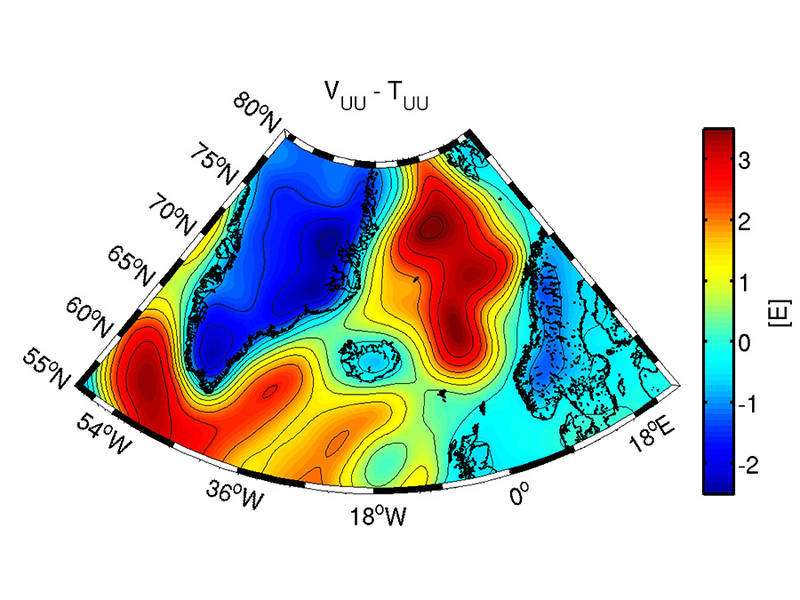Gravity glasses offer a view of the Earth's interior

How does the ice on the polar caps change? And which are the geological characteristics of the Earth's crust beneath? What is the structure of the boundary between the Earth's crust and mantle? Geophysicists will be able to answer these questions in the future using gravity field measurements from ESA's GOCE gravity satellite. Geodesists from the Technical University of Munich (TUM) have prepared the measurement data mathematically in such a way that they can be used to resolve structures deep below the surface.
If an astronaut could see gravity fields, then he would not perceive the Earth as round; instead, it would appear dented like a potato. The reason: the masses in oceans, continents and deep in the Earth's interior are not distributed equally. The gravitational force therefore differs from location to location. These variations, which are invisible to the human eye, have been measured by highly sensitive acceleration sensors on board the Gravity Field and Steady-State Ocean Circulation Explorer - GOCE for short.
The satellite transmitted several hundred million data records to ground control between 2009 and 2013. Groups of the TUM are significantly involved in the development of the mission and the analysis and application of the measurements. "This data has helped us to map the Earth's gravity field with great precision. And now - by putting on the gravity glasses - we can use the measurement values to see deep beneath the surface of our planet," explains Dr. Johannes Bouman from the German Geodetic Research Institute at TUM.
The Earth's crust becomes visible
On the gravity field maps that the team has now published in the online magazine Scientific Reports, you can recognize, for example, a wide, red stripe in the North Atlantic that symbolizes increased gravity. This is consistent with the plate tectonic model: between Greenland and Scandinavia thick and heavy material rises up from the Earth's mantle along the mid-ocean ridge, cools down and creates fresh oceanic crust. "With the gravity field measurements we can provide additional information to the plate tectonic model as we can draw conclusions regarding density and thickness of the different plates," says Bouman.
Algorithms offer new perspectives
Together with his team Bouman worked on preparing the GOCE data for two years. This data proved difficult to interpret because the satellite's height and orientation fluctuated as it orbited the Earth. "The location of the satellite could be pinpointed at any time using GPS, but you had to correlate each measurement with the coordinates saved when evaluating the data," recalls the TUM researcher. Using the algorithms that he developed with his team, he was able to transform the data in such a way as to enable geophysicists to use it without additional adjustments going forward.
Two grids - two eyes
The trick: the measurement values were not correlated with the actual trajectory of the satellite; instead, they were converted into two reference ellipsoids. These ellipsoids, which surround the Earth at heights of 225 and 255 kilometers, have a fixed height and their geographical orientation is defined, too. Each ellipsoid consists of 1.6 million grid points that can be combined. "In this way - as with stereoscopic vision with two eyes - you can make the third dimension visible. If you then combine this information with a geophysical model, you get a three-dimensional image of the Earth," explains Bouman.
"This method is very interesting for geophysicists," emphasizes Prof. Jörg Ebbing, Head of the Work Group for Geophysics and Geoinformation at the University of Kiel and also author of the paper. "Previously, the models were predominantly based on seismic measurements - from the course that seismic waves travel, you can deduce, for example, boundaries between the Earth's crust and mantle. This new data allows us to check and improve our ideas and perceptions."
Analyzing the Earth's crust in the North Atlantic is only the beginning. "Using the geodetic data from the GOCE mission, we will be able to examine the structure of the entire crust in more detail in the future," adds Prof. Florian Seitz, Director of the German Geodetic Research Institute at TUM. "And we will even be able to make dynamic movements visible, such as the melting of the polar ice sheets, which seismology could not see."
More information: Satellite gravity gradient grids for geophysics, www.nature.com/articles/srep21050
Journal information: Scientific Reports
Provided by Technical University Munich




















